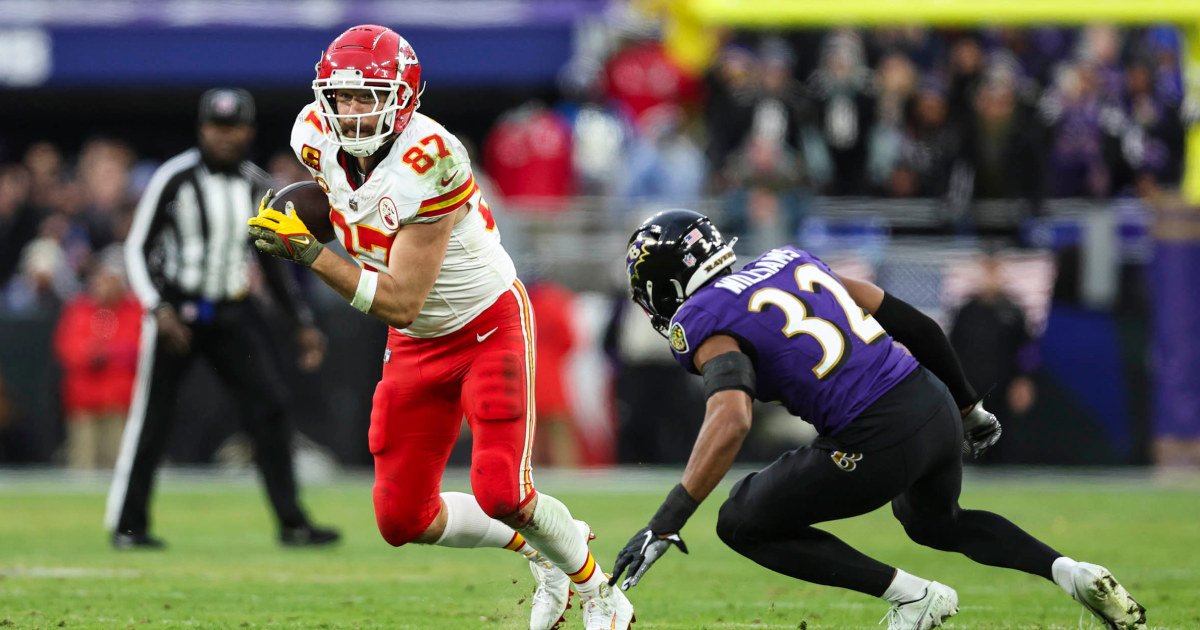
LAS VEGAS — In the spirit of Sin City, don’t bet against the NFL.
Sunday’s big game looks set to be one of the premiere American cultural events of the year, pitting defending champions the Kansas City Chiefs against the five-time Super Bowl-winning San Francisco 49ers.
Add in the mere hope of an appearance from international pop superstar Taylor Swift, and you’ve got the makings of a juggernaut.
The expected sky-high ratings will likely be a capstone to one of the most remarkable years in NFL history, at least in terms of television viewership. The league — not long ago seen by some detractors as a fading enterprise tarnished by controversy — could reach the apex of its influence and reach.
America’s obsession with football showed no signs of abating in 2023, cementing the NFL as one of the last vestiges of the monoculture in an era of fractured media consumption. NFL games made up a staggering 93 of the top 100 broadcast programs last year, according to data from Nielsen, a leading media measurement firm.
The increase was driven in part by popular “Monday Night Football” simulcasts on ESPN and ABC, not to mention the headline-grabbing courtship between Swift and star Chiefs tight end Travis Kelce.
NFL games are also more widely accessible on streaming platforms, if you’re willing to shell out for subscriptions — there’s the Sunday Ticket on YouTube TV, for example, and Thursday Night Football on Amazon Prime Video.
NFL programming continues to rise as a share of overall watch time, too: 38.62% of national traditional TV viewing on Jan. 28 was dedicated to the AFC and NFC championship games, according to Inscape, the data division of the consumer electronics company Vizio. Including studio coverage of those playoff games, the NFL accounted for nearly half of the traditional TV viewing minutes watched for the day, at 46.29%.
“As national linear [traditional] TV audiences shrink, the NFL is becoming one of the only games in town for remaining audiences and advertisers, and that shows from a programming standpoint,” said John Cassillo, an analyst at TVREV, a research group.
Syracuse University professor and TV historian Robert Thompson, who predicted that Sunday’s game could draw a whopping 114 million viewers, echoed that sentiment: “The Super Bowl is really the last of the truly communal TV experiences, making it not only immune to the audience decline that all other programming types are experiencing, but in fact positioned for growth.”
TV audiences also appear to be hungering for collective joy following the brutal isolation of the height of the Covid years.
“Post-pandemic, there’s that ongoing desire to be with and around other people” to watch this game, said University of Nevada, Las Vegas sociology professor and pop culture researcher Michael Borer, predicting that Swift would move the needle if she shows up at Allegiant Stadium to cheer on Kelce.
NFL’s rebirth
In the early 2010s, the NFL looked rock solid. The Super Bowl played in 2010, won 31-17 by the New Orleans Saints over the Indianapolis Colts, drew a then-record 106 million viewers, the first time the big game’s viewership had grown to nine digits. The average television viewership in the subsequent regular season reached 17.9 million.
It seemed at the time like there was nowhere to go but up as another record was broken in the 2015 game when an all-time high of 114.8 million Americans watched New England’s dramatic 28-24 victory over the Seattle Seahawks. Regular-season viewership went up to an average of 18.1 million that year.
But then something happened on the way to ratings infinity: Viewership went stagnant and, gasp, even declined.
Nielsen data shows that average television viewership for regular-season games dipped in the Donald Trump era, dropping to some 15 million in 2017.
During Trump’s first year in the White House, he dragged the NFL into the national culture wars by calling for players who kneeled for social justice during the national anthem to be fired. The ratings-obsessed president blamed the league’s viewership slump on the protests.
But even before Trump, the league was dogged by years of negative headlines around head injuries suffered by some of its players, which put a harsh spotlight on the physical toll of the game. Youth participation in football fell. Barack Obama famously said that if he had a son, he wouldn’t want him to play pro football.
“It was the height of the social justice movement and also the brain injuries were, no pun intended, on everyone’s mind,” Borer said.
The 2019 title game slipped back down to eight digits as 98.9 million people tuned into what’s widely regarded as the most boring recent title game, as New England beat the Los Angeles Rams, 13-3, in a defensive-minded snoozer.
Then another sub-100 million audience of 95.8 million checked in for the Covid season’s title game, won by ageless wonder Tom Brady and his Tampa Bay Buccaneers, 31-9, over the Chiefs in 2021.
Jason Lynch, a curator at the Paley Center for Media, insisted those down years had nothing to do with event’s baseline popularity and could easily be tied to randomly bad play on the field.
“What impacts the ratings more is whether the game is competitive or not,” said Lynch, creator of the museum’s exhibit “Beyond the Big Game.” “If you have a game like in 2021, the Tampa Bay-Kansas City matchup, that was pretty lopsided from the beginning. There was no reason for people to stick around. The ratings are the average number of viewers who watch per minute, and by the second half of the game, there were far fewer people watching.”
Since that 2021 flub, the Super Bowl has come back with consecutive improvements, as audiences of 101 million and 113 million tuned into and clicked on the last two title games. Regular-season numbers also rebounded over the last three years; an average of 17.9 million viewers tuned into regular-season games last year, according to Nielsen data.
Lynch argued the NFL isn’t bouncing back as much as it’s shaking off a few years of anomalies.
“A 10 million swing in direction, that’s not nothing,” Lynch said. But when the baseline is about 100 million viewers, he added, “that’s just a 10% drop.”
“Let’s say your average hit broadcast drama or comedy, maybe you’re going to bring in 10 million, which is a best-case scenario at this point,” Lynch said. “A 10% drop from that is only 1 million. That’s incredibly common week to week. But it’s more pronounced [in the Super Bowl] because these numbers are so much larger.”
The hype of this year’s game has surely been pushed by “the perpetually discussed ‘Taylor Swift effect,’ breathlessly waiting if she makes it back from Tokyo” from a Super Bowl-eve show in the Japanese capital, Thompson said.
Borer, the UNLV sociology professor, agreed that Swift has gotten a cohort of viewers hooked on football — even if it’s just to watch her cheering in the stands.
“She’s gotten more people into seeing the game and seeing her, it’s wild,” Borer said. “Even those few glimpses of her during the game, people who are not fans [of football] are really excited by that. It brings different demographics. Swifties are girls to middle-aged women, maybe a demographic that’s not the typical NFL fan.”
It’s impossible to downplay Swift’s potential impact on Sunday.
“There’s going to be part of the population where Taylor is going to be their reason to watch this game, a chance to see her,” Lynch said. “If it turns out that this year’s game is the most watched, which CBS is certainly hoping is going to be the case, I think Taylor will probably be the thing that’ll help put it over the top.”
David K. Li reported from Las Vegas and Daniel Arkin from New York City.
Source: | This article originally belongs to Nbcnews.com









